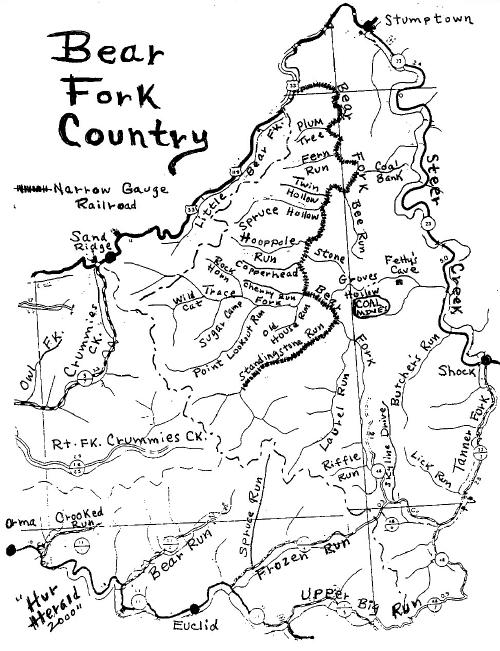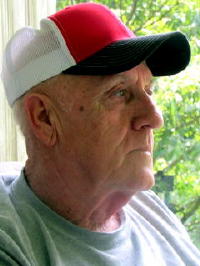
Map shows main railroad line, but does not show the extensions to the Right Fork of Crummis Creek or to Frozen, Spruce and Nicut, nor the mainline to the Elk River
By Bob Weaver
Victor Summers recalls some of the early Bear Fork Wilderness families that settled in the backwoods, based on conversations with his father-in-law Noah Cottrell before his passing.
 Summers has lived most of his life on the edge of the wilderness on Crummies (Crummis) Creek, and with his help has developed a first list of the pioneers. It is likely that over 100 families lived in the wilderness.
Summers has lived most of his life on the edge of the wilderness on Crummies (Crummis) Creek, and with his help has developed a first list of the pioneers. It is likely that over 100 families lived in the wilderness.
It appears that Thomas Cottrell was among the earliest settlers there, connected to early comers Peter McCune, Adam O'Brian, Peter Cogar, Isaac Mace, Phillip Starcher and William Brannon.
The wilderness area was expansive (likely up 50,000 acres), owned by Weston's Bennett Family in three counties Gilmer, Calhoun and Braxton, attracting early comers right after 1800, all being permitted to live on the acreage without ownership, some sustaining themselves for three generations.
Every stream and hollow had a name:
French Cottrell, Sugar Camp
John Lawson, Spruce
Mac/Pete Wayne, Sugar Camp
Harvey Simmons, Laurel
Keith Loudin, Fern Run
William Groves, HoopHole
Myrt (male) Groves, Trace Fork
James Carpenter, Mouth of Trace
Leven Nicholas (1756) and Zephhiah Nicholas, Jr. (1764) came to Bear Fork about 1820, Bear Run
Michael White, Spruce
Jacob Bourne, Spruce
John and Laura Hill Bourne, StandingStone
Schartiger, StandingStone
Soleman and John Cottrell
Andrew Sampson, StandingStone
Avery Woods, main Bear Fork
Saul McCune, Wildcat
George Campbell, Buckhorn
Harley Schoolcraft, Trace
Minter Carr (16 children) Sugar Camp
Harson Parsons, Sugar Camp
Curt Parsons, Crummies (Crummis) Creek
Libby Owens/Bud Ratcliff (Black), Coal Bank Hollow
There are at least four prominent cemeteries, Groves, Lawson. Nicholas, Lambert and Boone, with at least one cemetery with two deceased Civil War veterans (one being a Schoolcraft) being buried about 1909 near an original school about 1909.
Two one room schools were built early 1900 in Bill Groves Hollow and Trace Fork.
Creed Yoak had a store and boarding house at the Mouth of Trace.
Primitive trees five feet through stood on the land, some nearly 100 feet tall, many of them Chestnut.
In the early 1900s, many men worked on the timbering of the forest for barrel staves, hauled from the region by a narrow gauge railroad to a main railroad line on the Elk River, Gassaway.
SEE many Hur Herald stories TALES OF BEAR FORK.
| 


